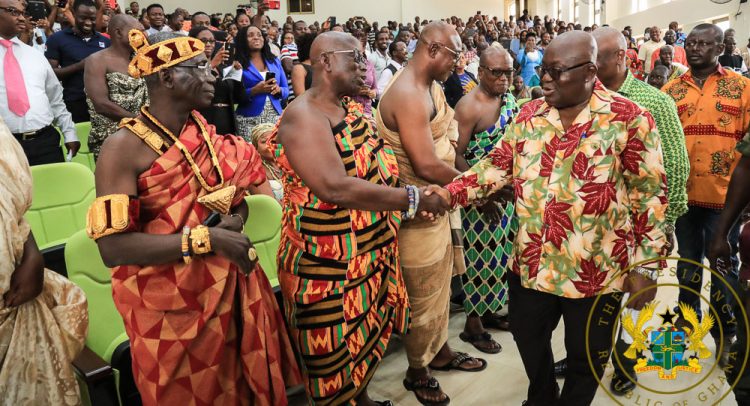President Akufo-Addo interacting with chiefs at the University of Health and Allied Sciences
President Akufo-Addo has expressed worry over attempts by some people, including chiefs and politicians, to antagonise those who initiated the creation of the new regions in the country.
The president reiterated that there is no political agenda in the proposed creation of six more regions in the country.
According him, “I am not doing it for votes, there are plenty of regions in this country where they don’t vote for me. Why would it be any different if these regions are created?”
He said “there is no political agenda in this matter, and there is no attempt to create ethnic antagonisms or factions in this exercise. It is meant to try and improve the governance of our people.”
History
Speaking at Adaklu yesterday on the second day of his three-day tour of the Volta Region, he recounted the history behind the creation of regions in Ghana, noting that “in 1952, the Western and Eastern Regions were created, bringing the total number of regions in Ghana to four.
The Plebiscite of 1956 ensured that Trans-Volta Togoland became the country’s 5th region.
“After Independence, Kwame Nkrumah’s CPP government created Brong-Ahafo Region. They also created the Central Region, and then the Upper Region was created out of the North. So by the mid-60s, we had now moved from three regions to eight regions. Then Jerry John Rawlings’ PNDC government came and divided the Upper Region into North, Upper West and Upper East,” he said.
The President said he recounted the history to show that “the regional structuring of our country has not been static. It has taken into account developments, population growth, the need to improve the quality of governance and take it closer and closer to the people because that is the most effective governance that we have.”
Oti Region
Referring to the Volta Region, the President emphasized that the people of Southern Volta and those in Oti enclave should not fight each other over the plans to create a new region to compromise the peace that exists between them, saying that the territorial split would benefit all.
“Although the creation of the new regions was initiated by the people themselves, there is no reason for those in the areas from which the new regions would be created to antagonize the initiators.
“Instead the creation should foster more unity and not compromise the peace, as both old regions and new ones, will have adequate resources exclusive to them without having to share in pieces over a larger area,” he added.
Unity
He said “in the Volta Region where Oti Region is earmarked to be created, we should not see it (new regions) in any antagonistic way, nor should it be a reason to plot against each other. More so, there should not be any form of ethnic misunderstanding between the Northern Volta and Southern Volta over the creation of Oti Region. Instead the Southern Volta should be seen guiding the new region to stand on its feet as it will equally be in its interest to have the Oti Region.
He explained that with the new region, the resources for the current Volta Region would not be compromised but optimized.
“They will be focused on the middle to Southern Volta while the Oti Region will also have its own resources to develop its area. Just as the constitution was followed to create the earlier regions, the same constitution will be followed to ensure a lawful and legitimate creation of the six new regions (two each from Northern and Brong Ahafo regions and one each from Volta and Western regions).
The President inspected the Youth Resource and Development Center of Excellence at Adaklu and two facilities at the University of Health and Allied Sciences at Sokode Lokoe, near Ho, in the Volta Regional Capital.
Inspection of Projects
Touching on the state-of-the-art 10,000 seater Youth Resource Center at Adaklu, the Sports Minister, Isaac Asiamah said the facility, when completed, would have a FIFA standard pitch, eight-lane athletic track, handball, basketball and netball courts.
He said the facility would also have 78-table restaurant, a VIP stand, two changing rooms, a counselling center and offices for the National Youth Authority.
The project, which is 26 percent complete, began in April this year, and is expected to be completed in January 2019.
It’s being executed by Wilkado Construction Works with Joe Kinsley Hackam as the consultant.
At UHAS, the Vice Chancellor, Prof. John Gyapong and his administration held a closed door meeting with the President.
The President also inspected two major projects- a two-storey Pharmacy Department building, which is expected to be completed in 12 months’ time.
The project, which is being funded by GETFund at the cost of GH¢3.5million, would have six classrooms, six offices and a laboratory, among others.
He inspected also the laboratory complex for the university which is also being funded by the GETFund with First Sky Group as the contractor.
The Vice Chancellor said the university, which started with 154 students, now has over 3,500 students, and is bedeviled with a myriad of problems.
From Fred Duodu, Ho (k.duodu@yahoo.com)


